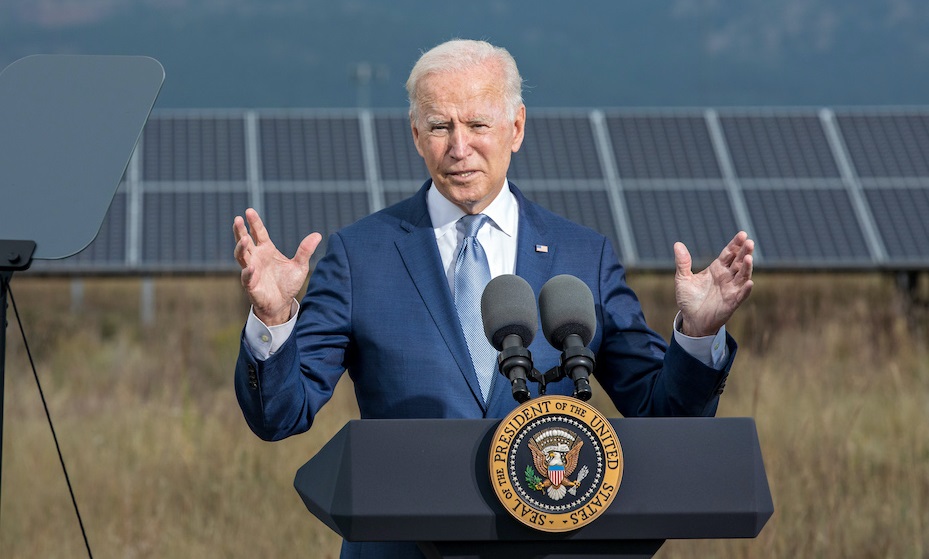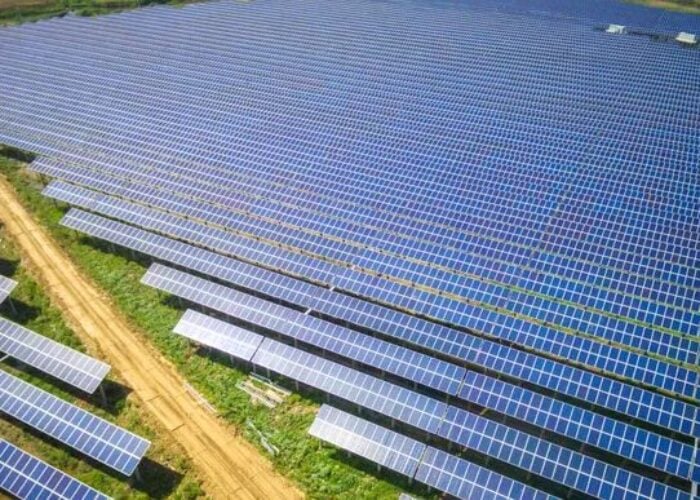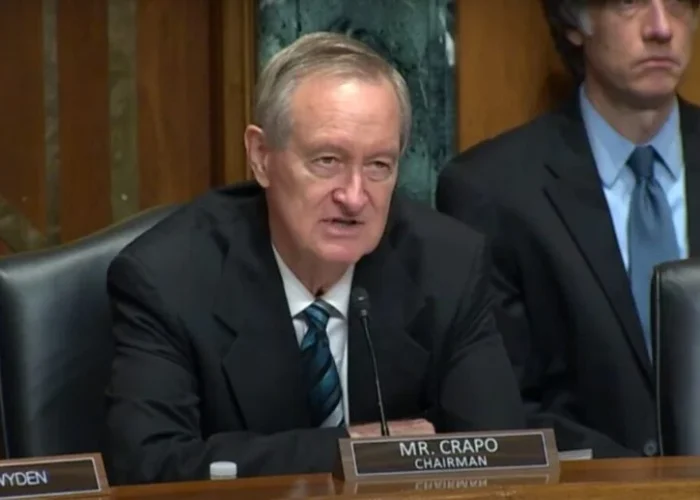
The US solar market was widely expected to thrive this year, but various policy headwinds have destabilised the module procurement market and created uncertainty to such an extent installations stalled. Liam Stoker reflects on events of the last 12 months.
When President Biden assumed office in January 2021 there was every expectation that a light at the end of the tunnel for US renewables had been reached. A ceremonial re-joining of the Paris Climate Agreement would pave the way for a suite of supportive policies designed to send the market back up the renewables rankings, buoyed by gigawatts upon gigawatts of deployment.
Unlock unlimited access for 12 whole months of distinctive global analysis
Photovoltaics International is now included.
- Regular insight and analysis of the industry’s biggest developments
- In-depth interviews with the industry’s leading figures
- Unlimited digital access to the PV Tech Power journal catalogue
- Unlimited digital access to the Photovoltaics International journal catalogue
- Access to more than 1,000 technical papers
- Discounts on Solar Media’s portfolio of events, in-person and virtual
But, so far, that has yet to come to pass. And indeed, so great has the policy uncertainty been in relation to renewables – and solar in particular – that some developers earlier this year remarked that Biden had, in fact, been worse for the industry than even his predecessor.
Since the president’s inauguration, the solar industry has had to face two consecutive anti-dumping and countervailing duty (AD/CVD) investigations, an extension of Section 201 tariffs, a withhold release order on polysilicon from Hoshine and a toughened stance on products from China’s Xinjiang region owing to forced labour concerns.
While Biden secured a major policy victory with the passage of the Inflation Reduction Act – including a host of provisions to boost solar deployment and manufacturing – last week, his tenure as president has not been the smooth sailing the US industry had hoped for.
This has resulted in markedly weaker deployment forecasts for this year, caused by the upheaval in module procurement that has sent developers sprawling for alternative, often pricier modules.
The extent of delays and project pushbacks has been highlighted in two recent studies in particular. Analysis of satellite data by tech analyst Kayrros concluded that one-third of utility-scale solar projects in Texas expected to complete this year have either not started yet or been placed on hold, while the American Clean Power Association recorded a 53% slump in utility-scale solar installations US-wide in Q2 2022, driven entirely by policy headwinds and trade issues.
Axed because of Auxin
Developers in the US have concluded that of all the headwinds they have faced, it is the AD/CVD investigation(s) that have wreaked the most damage. While other developments have made module procurement more difficult or inflated prices, none have effectively stopped PV module shipments overnight in such a way that the AD/CVD investigation did.
In that respect, it is of more pertinence for developers that Biden’s subsequent intervention – to effectively waive those tariffs for two years – removed a considerable amount of uncertainty in the market. Paul Wormser, vice president at Clean Energy Associates, says that uncertainty was effectively a barrier on numerous facets of solar procurement in the US, to factories running at full speed, to shipments entering the US and to contract negotiations on new supply, wholly because the AD/CVD risk was perceived to be so significant.
By removing that risk – if only for a two-year period while the Department of Commerce’s investigation proceeds in the background – Wormser says modules can now start to ship and projects start to progress.
But, there is a caveat to this point. While supply lines to the US have been reopened by Biden’s intervention, it merely means that the significant amount of latent demand in the US market can be satisfied. Demand for modules in the US market had been building for more than a year before Biden’s AD/CVD intervention, with module supply disrupted by the withhold release order on products linked to polysilicon products made by Hoshine Silicon.
“We did not see demand destruction, but we saw demand delay because of shipments being delayed,” Wormser says, adding: “And that means that the demand right now is what you might think of as a bubble”.
The AD/CVD investigation merely served to exacerbate the situation and allow that bubble to grow larger, with manufacturers that have been able to cater for the US market now increasingly sold out through 2022 and 2023. One, Wormser says, is sold out through 2024.
So if the AD/CVD investigation had caused pent-up demand to continue to build, simply suspending that risk will not be an immediate panacea to the US solar industry’s supply chain woes. And it certainly did not prove to be that way, with yet another policy spanner in the shape of the Uyghur Forced Labor Prevention Act (UFLPA) coming into force just months later.
AD/CVD: A timeline
August 2021: A group of anonymous solar manufacturers, dubbed the American Solar Manufacturers Against Chinese Circumvention (A-SMACC), petitions the US Department of Commerce to investigate alleged circumvention of AD/CVD tariffs by manufacturers based across Southeast Asia.
September 2021: The Department of Commerce delays its verdict on the A-SMACC petition, requesting new information to proceed, including the identities of those companies included within the group.
November 2021: The Department of Commerce rejects the A-SMACC petition, citing the ongoing anonymity of those included within the group as an obstacle to further proceedings.
February 2022: Auxin Solar, a hitherto little-known US module manufacturer, launches a new petition with the US Department of Commerce to investigate potential circumvention of AD/CVD tariffs by Southeast Asia-based manufacturers.
March 2022: The Department of Commerce confirms it will investigate alleged AD/CVD circumvention following Auxin Solar’s petition, effectively halting US module supply from Southeast Asia.
May 2022: Eight major module manufacturers with operations in Southeast Asia are selected as mandatory respondents to Commerce’s investigation.
June 2022: With the investigation still ongoing, the Biden administration confirms it will waive certain trade tariffs on solar products for two years, effectively meaning AD/ CVD tariffs will not be implemented until June 2024 at the earliest.
August 2022: The preliminary findings of the Department of Commerce’s investigation are announced.
January – April 2023: A final decision on the investigation, including any prospective tariff rates, are to be announced by the Department of Commerce.
A tough stance on forced labour
After passing the US Senate late last year, in June the UFLPA came into force, effectively prohibiting the import of products linked to China’s Xinjiang region over allegations of forced labour. Modelled on previous policy tackling forced labour accusations, the UFLPA assumes that any items “wholly or in part” made in Xinjiang are prohibited from entering the US.
Given the region’s connections with polysilicon production and a general lack of existing traceability documentation – with the UFLPA requiring documentation down to the quartzite level – it had initially been feared that the requirements for entry would be higher than previously thought. This fear was not eased when news of the first shipments being stopped under the UFLPA spread earlier this summer.
But while those fears have not exactly proven unfounded, the Solar Energy Industries Association has moved to dispel outright concerns by stressing that most US solar importers should be able to meet those requirements. It may, however, take time for documentation to be processed and the act has certainly been identified as yet another stumbling block for modules made in Southeast Asia to ship to the US freely.
This has given fresh impetus to calls for the US to get serious on its domestic solar manufacturing footprint, something which – alongside an extension to investment tax credits (ITCs), which would add further certainty for the US solar downstream community – would give the sector the jumpstart it needs.
All eyes, therefore, fell on Capitol Hill and, more specifically, one senator in particular.
Manchin machinations
The US solar community has placed significant importance on the passage of Biden’s Build Back Better (BBB) agenda, given how it would provide such considerable certainty for not just downstream supports, but investment in upstream.
The Solar Energy Manufacturing for America (SEMA) Act, as proposed by Georgia senator Jon Ossoff, stands to drastically overhaul the way the US government supports domestic solar manufacturing, offering incentives for each unit of polysilicon, solar wafers, cells and modules produced within the US. Domestic module makers such as First Solar have championed its importance to such an extent that the company has reportedly suggested future capacity expansions would take place outside of the US, and in Europe or India instead, were it not to pass.
Likewise, international module manufacturers with existing capacity in the US such as Qcells have stressed that if they are to even entertain expanding module capacity in the US, then incentives such as SEMA are imperative.
“This industry clearly needs some kind of incentive or subsidy… From the cost perspective [outlined in Senator Jon Ossoff’s SEMA proposal], we are satisfied. If that policy support is in place, we may consider it,” says Justin Lee, CEO at Qcells.
An extension for solar ITCs – a cornerstone of Biden’s election campaigning around climate issues – has too long been part of BBB, and would pave the way for tens of gigawatts of additional solar to reach financial close in the US in the coming years, Wood Mackenzie has highlighted.
BBB, enacted through the US’ budget reconciliation process to avoid the need of an outright majority in the House, faced months of delays due to West Virginia senator Joe Manchin. The Democrat, who occupies the party’s right alongside Arizona senator Kyrsten Sinema, effectively stonewalled the bill’s passage, labelling its multi-trillion-dollar spending bill as reckless. Initially expected to pass as early as November 2021, by July, with negotiations having broken down numerous times and relations within the Democrats fraught, many industry observers and politicos considered the legislation dead in the water. ROTH Capital’s Phil Shen gave it just a 10% chance of passing, and even that may have been generous.
“The renewables industry, solar included, has never had a period in its future where it had policy certainty for ten-plus years”
But in late July, with negotiations feared all but dead, Manchin and Senate majority leader Chuck Schumer announced a shock breakthrough. Manchin confirmed that he would support a bill that included various climate supports, including not only a ten-year ITC extension and a version of SEMA, but an ITC for standalone energy storage, long regarded as a much-needed enabler for the broader energy transition.
Wrapped up as part of a broader bill to tackle the threat of inflation, Manchin said the bill will “ensure our country invests in the energy security and climate change solutions we need to remain a global superpower through innovation rather than elimination” in a statement issued on 27 July 2022.
The following weeks saw the bill, dubbed the Inflation Reduction Act, pass both chambers of Congress before landing on Biden’s desk to sign into law on 17 August. Earmarking US$369 billion for decarbonisation efforts, the act was described by the president as “the biggest step forward on climate ever”.
Provisions included look set to lay the groundwork for accelerated PV deployment, with research from Princeton University projecting that the country could have as much as 49GW of solar installed per year by 2025, around five times higher than capacity additions in 2022. Wood Mackenzie, meanwhile, forecasts that the act will increase US utility-scale solar capacity buildout by 86% over the next ten years when compared to a scenario without tax credits.
The act will enable solar developers and manufacturers to make investments knowing that the policies will be in place for ten-plus years, according to Christopher Seiple, vice chairman of energy transition and power and renewables practice at Wood Mackenzie. “The renewables industry, solar included, has never had a period in its future where it had policy certainty for ten-plus years,” he says. “We’ve always called it the ‘solarcoaster’, because of this whiplash from year to year responding to different policies.”
Jessica Lawrence-Vaca, vice president for government affairs at EPC contractor SOLV Energy, says the Inflation Reduction Act provides certainty from a procurement standpoint for the company, adding: “I think all of our partners across the board are really excited about the possibility here because the long-term certainty is just so critical to being able to grow, plan and do business.”
Attention now shifts to the outcome of the Department of Commerce’s AD/ CVD investigation, and whether the Inflation Reduction Act and other legislation like the Bipartisan Infrastructure Law can help create a homegrown US solar manufacturing industry, regardless of that investigation’s outcome. As always, the industry awaits the next twists and turns of the US ‘solarcoaster’.
Additional reporting by Jules Scully.







